Eggplant
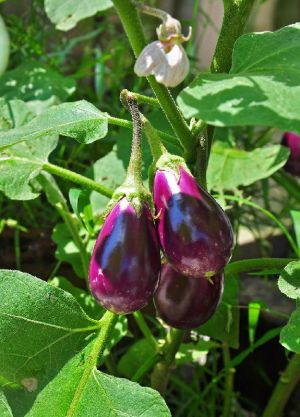
Aubergines are best grown under cover, on tarpaulin or mulch. It requires and can be harvested quickly.
Preparing the soil
Aubergines are a demanding crop (particularly in terms of sulphur), so we recommend adding plant compost, animal manure, etc. to the soil. In addition, fertigation can be carried out during the season.
Aubergines are grown on tarpaulin or mulch. Straw is added to the greenhouses by hand to a thickness of
10 to 30 cm thick. Be careful when planting at the start of the season, because in the event of frost, the straw prevents the warmth of the soil from protecting the plants. To avoid this, the straw
straw is added manually later in the season.
Similarly, warm soil is essential for good plant
plants to take root. For this reason, planting under a tarpaulin (silage or woven) is recommended, especially in regions that don't get as much sun or for the first few weeks.
less sunny regions or for the first series.
series. Before installing the tarpaulin, it is advisable to
water the planting area thoroughly by sprinkling.
Finally, aubergines don't do well in soils that are too wet
for heavy, clayey soils, it is possible to grow them on mounds.
for heavy, clay soils.
Planting
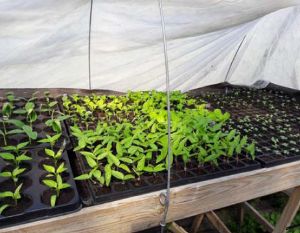
Seedlings are sown in a nurs ery 7 to 10 weeks before planting and then repotted. then repotted. To obtain vigorous vigorous, stocky plants, it is advisable to maximise photosynthesis by spacing the plants apart. Aubergine plants are demanding, their germination temperature is fairly high germination temperature is fairly high, and large temperature day and night are not appreciated. The plants also need a large amount of light; if the temperature is warm If the temperature is warm but there is a lack of light, the plants will wilt. They therefore need to be protected until they are planted.
Planting is done by hand, ideally at the
5/6 true leaves, without burying the crown. For earlier production, aubergines can be planted earlier, using forcing sails at night to protect them from the cold.
from the cold. Planting early is a risk that can be taken for part of the production.
part of the production.
Crop monitoring
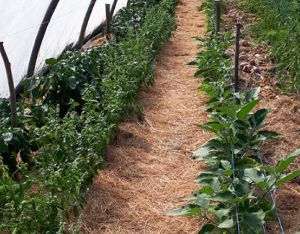
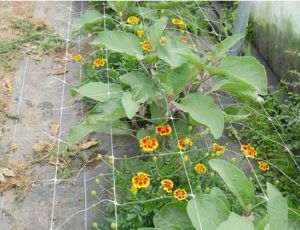
There are several systems for staking vigorous aubergine plants :
- A string is attached to the support or a cotton thread mounted on a spool. The stalk or stalks are either rolled up (risk of breakage) or clipped on so that the crop can be easily attached to the wire.
- Horizontal trellising : multi-tiered cages made from concrete trellis or sheep netting, placed around the plant in the first few weeks. The plant is then staked 2 to 4 times during the growing season (every 30 to 40 cm) to prevent the stems breaking when the fruit forms.
- Pruning consists of keeping 3 to 5 main stems and removing some of the flowers when several form in the same place, to keep only a few good-sized fruits. For greater earliness, a single branch may be kept.
Tip
Take care when staking grafted aubergines, which can grow very high, to avoid losses.
Irrigation
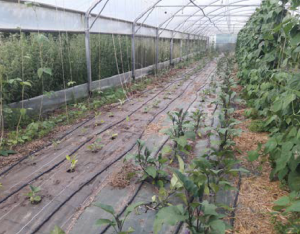
Irrigation is by drip or sprinkler, avoiding
watering with cold water. Generous irrigation is
irrigation is required at planting to ensure good plant
of the plants. Irrigation should be regular but not heavy,
adapted to the weather and in the morning. It is during
when the fruit is developing that the needs are most
most important.
Variety
- Non-hybrid : Rouge Longue violette, Ronde de Valence.
- Hybrid and rootstock : better earliness and productivity for aubergines.
Harvest
Harvesting is carried out once or twice a week by hand with secateurs. The fruit is harvested at a suitable size, colourful and still firm. Washing the cutting tools regularly to prevent disease.
Storage
Aubergines can be stored for a fortnight in a cool room or in a cellar. Storage temperature : Ideally 12°C
Pests and diseases
- Colorado beetles are the main pests : harvest by hand (sweep up plants).
- Aphids, especially on young plants : ladybird larvae are spontaneous regulators. In the event of invasion, spraying with black soap is a solution.
- Bugs can cause flowers to abort : harvest by hand.
- Mildew : prevention and control of humidity levels by ventilating the shelters and watering in the morning.
- Botrytis and Verticillium : choose varieties and grafted plants.
Adapting to the soil and climate
Cultivation starts earlier and lasts longer in warm regions with few frosts. Wintering sails andNantais tunnels can be used to improve earliness.
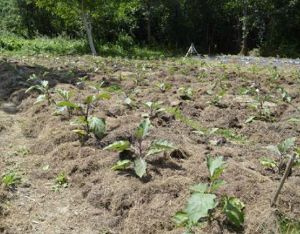
Possible ITK variations
Aubergines can be grown outdoors, especially in southern regions. yields will be lower.
Photo gallery
Sources
- This page is based on the guide Introduction au maraîchage sol vivant from MSV Normandie.
